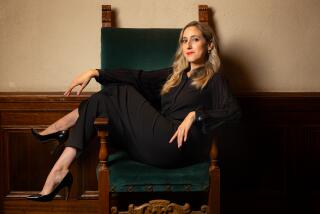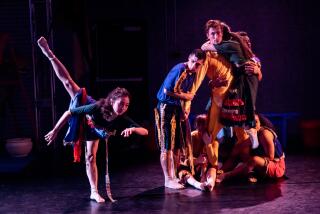UCLA TO BE A PLACE OF COURTLY ELEGANCE
- Share via
“Courtly” doesn’t usually describe the teeming, hectic UCLA campus. But when the UCLA College of Fine Arts presents its “Evening of the Courtly Arts” Friday through Sunday, music and dance audiences may find themselves transported back to a setting of ceremonial elegance.
With three simultaneous performances taking place at one indoor and two outdoor campus locations, audience members will have an opportunity to wander from a Javanese palace to a Japanese Shinto shrine to an Italian Renaissance ballroom--all re-created by the UCLA dance, music and theater arts departments.
This experimental project was conceived by Judy Mitoma, associate dance professor and head of the campus World Arts and Cultures program. “Our plan is to immerse audiences in environments, and it’s important for them to compare these dances in full context, so they’ll be aware of similarities as well as differences,” she says.
Dance professor Emma Lewis Thomas, director of the Italian Renaissance segment, adds that “court dances anywhere are the same in that they’re formal, structured, carefully laid out. Dancers make ritualized entrances wearing stylized attire, and their demeanor is contained. Usually they take small steps, with knees close together, and there’s a sculptured quality to the line.”
A sampling of each dance form reveals other likenesses--they are all stately, disciplined, slow in tempo and appear to require intense concentration. However, each is richly different in appearance and execution.
Javanese Srimpi dancers wear blue tunics and long batik cotton skirts cinched with floor-length scarfs that become part of the choreography as they are flipped around the hands and out again. Most of the action occurs in the upper body--heads are tilted, hand movements are delicate and subtle.
The ancient Japanese Bugaku also emphasizes the upper body, but the arm movements are larger and more sweeping, the footwork more percussive. Silk costumes are paired with tall golden helmets and some wooden masks are used.
In comparison with Asian dance, 14th-Century Italian dance seems freer and less constricted, but only by degree. It’s measured and dignified, even when lively and playful, with larger but restrained and studied arm and leg movements.
For all their differences in style, court dances are the same in that they were developed as a part of daily court life. In Java, according to Mitoma, court dance was “originally practiced by the sultan and his children to develop the contemplative control essential for people in power.
“Teaching this to Western students is difficult,” she adds. “In Western dance we move limbs through space; in Javanese we move joints. It takes students a while to kinetically understand that movement is smaller and slower.”
Dance and music visiting lecturer Suenobu Togi, a descendant of an unbroken family line of court dancers dating back 1,000 years, is artistic director for the Bugaku segment, to be accompanied by the UCLA Gagaku ensemble.
In Bugaku, according to Togi, “form is more important than story. It was associated with the temple, but made for the emperor’s appreciation. It’s very formal, no emotion is shown, and the essence is in the movements, which may have no meaning but are used for their beauty or purity.
Although Javanese and Japanese dance have been preserved for centuries, Italian Renaissance dance, with no courts to perpetuate it, has not. For many years Thomas has been reconstructing this dance form from old manuals.
For her segment of the program, she will use dances written about by Boccaccio in “The Decameron,” with choreography translated from a 15th-Century manual by Domenico da Piacenza.
“These dances are difficult for my students to learn because often the rhythm is intricate,” says Thomas. “The music is improvised but the dance is not, so dancers must hold their own rhythm while they work within space patterns. Also, the slow movements require considerable control and students need to develop the nuances of hand and foot placement.”
To maintain a feeling of royal court intimacy, only 400 tickets will be sold each night of the courtly arts program. According to Mitoma, “The basis for art is the joining of the audience with the performance. We hope the atmosphere we’ve created will encourage them to use their imaginations to complete the illusion and so allow them to participate.”
More to Read
The biggest entertainment stories
Get our big stories about Hollywood, film, television, music, arts, culture and more right in your inbox as soon as they publish.
You may occasionally receive promotional content from the Los Angeles Times.










